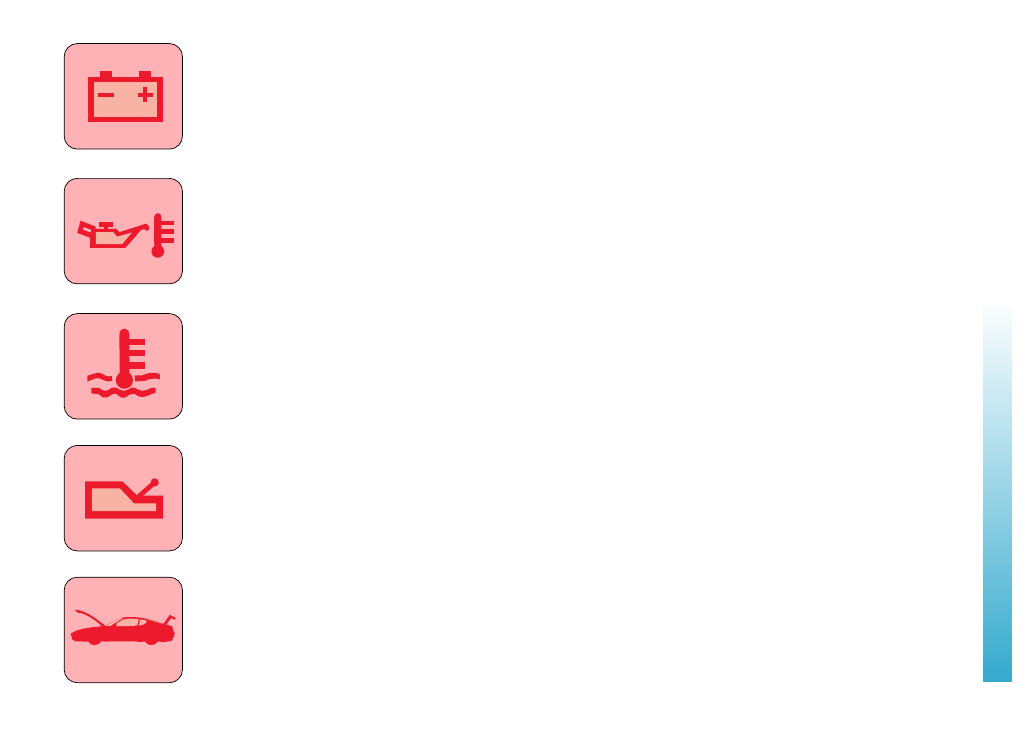Ferrari 456M GT and GTA (2003 year). Manual - part 8

H
13
Batteria scarica
La sua accensione si ha quando:
la batteria deve essere ricaricata
oppure in presenza di un’anoma-
lia nell’impianto di generazione di
corrente.
Elevata temperatura olio
La sua accensione segnala che la
temperatura dell’olio è troppo ele-
vata ed è consigliabile ridurre il
regime di rotazione del motore.
Elevata temperatura acqua
La sua accensione segnala che la
temperatura dell’acqua è troppo
elevata ed è necessario spegnere
immediatamente il motore.
Avaria cambio automatico
La sua accensione segnala un’ano-
malia nel sistema di gestione cam-
bio. (GTA)
Cofano motore e baule aperti
La sua accensione segnala l’aper-
tura o la non corretta chiusura del
baule e del cofano.
Down battery
When this symbol is displayed,
the following could have occurred:
the battery needs recharging or
there is a failure in the power
generating system.
High oil temperature
This symbol is displayed to sig-
nal that the oil temperature is too
high and the engine rpm should
be reduced.
High water temperature
This symbol is displayed to sig-
nal that the water temperature is
too high and the engine should
be stopped immediately.
Automatic transmission failure
This symbol is displayed to sig-
nal a failure in the transmission
management system. (GTA)
Open engine hood and luggage
compartment cover
When this symbol is displayed,
the engine hood and luggage
compartment cover are open and/
or incorrectly closed.
Batterie déchargée
Ce témoin s’éclaire dans les cas
suivants:
la batterie doit être rechargée ou
une anomalie de l’installation du
générateur de courant a été dé-
tectée.
Température d’huile excessive
Ce témoin signale que la tempé-
rature de l’huile est trop élevée.
Il convient donc de réduire le ré-
gime de rotation du moteur.
Température d’eau excessive
Ce témoin signale que la tempé-
rature de l’eau est trop élevée;
dans ce cas, il faut arrêter immé-
diatement le moteur.
Panne de boîte automatique
Ce témoin s’illumine en cas de
panne du système de gestion de
la boîte de vitesses. (GTA)
Capot avant et capot de coffre
ouverts
L’allumage de ce témoin signale
l’ouverture ou la fermeture non
correctes du capot avant et du
capot de coffre.
Batterie entladen
Dieses Symbol könnte unter folgen-
den Umständen aufleuchten: Die
Batterie muß neu geladen werden;
Fehlbetrieb des Stromalternators.
Zu hohe Öltemperatur
Leuchtet dieses Symbol auf, so
bedeutet dies, daß die Öltempera-
tur zu stark gestiegen ist und es
empfiehlt sich, die Motordrehzahl
zu drosseln.
Hohe Wassertemperatur
Leuchtet dieses Symbol so bedeu-
tet dies, daß die Wassertemperatur
zu hoch ist und daß der Motor so-
fort abgestellt werden muß.
Fehlbetrieb des automatischen
Getriebes
Leuchtet dieses Symbol so bedeu-
tet dies, daß im Getriebesystem ein
Fehler aufgetreten ist. (GTA)
Motor- und Kofferraum geöffnet
Wenn dieses Symbol leuchtet, so
ist eine Haube offen oder nicht
korrekt geschlossen.